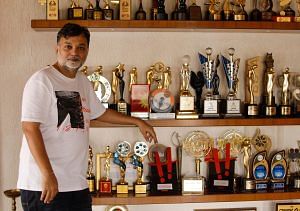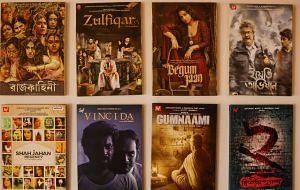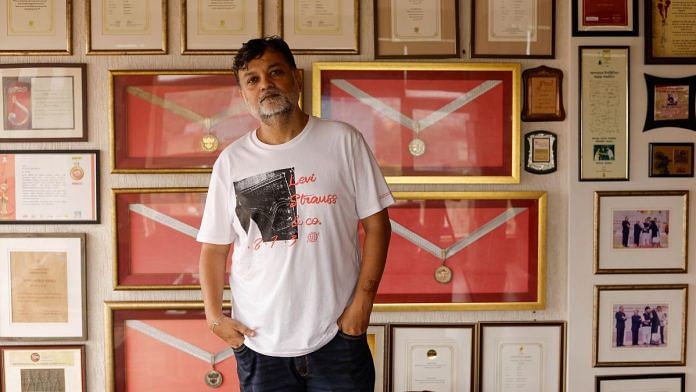Kolkata: Bengali film director Srijit Mukherji’s next project will shatter the popular ‘cultured but effeminate’ notion about Bengali men. From Baishe Srabon to Vinci Da, his movies counter the lens Bollywood has held for long when it comes to the average Bengali man. And his work is even more searing at a time when Karan Johar’s Rocky aur Rani ki Prem Kahaani has birthed a new round of public debate about Bengali masculinity.
Leaning back on his plush sofa on the second floor of his duplex apartment in south Kolkata’s Lake Gardens, Mukherji takes a breather before the workday seizes him. He has little time to rest. After all, his multi-starrer, double prequel Dawshom Awbotaar, is set to release on 19 October. It will unveil Bengal’s first ‘cop verse’ and bring back two shit-talking, bone-cracking Bengali policemen on screen.
“The men I write for my films are not softies. Yes, there is the cultured, genteel kind, but there are also hypermasculine men I write for my cinema, who are drawn from men I see around me,” Mukherji tells ThePrint.
Breaking stereotypes
In Mukherji’s world, the hypermasculine cop is not a solo traveller. If there are violent police officers with a propensity for third-degree torture inside lockups, there are also killers who like carving their names with knives on the foreheads of their victims. If his cinema is about superstars in search of a last hurrah or monks who were kings before, it is also about hardened criminals, psychotic cops, blood, gore and filth.

Mukherji didn’t set out to break preconceived notions about Bengali men. As he wrote his stories, these characters developed organically.
“You can say some of my male characters are hypermasculine, aggressive, violent even. But are there not such men around us?”
Mukherji finds it strange that Bollywood seems to think otherwise. Tota Roy Chowdhury’s character from Rocky Aur Rani Ki Prem Kahaani is a stereotype he strongly disagrees with.
“Tota was brilliant, but somehow Bollywood has, over time, fetishised the Bengali man. I do not think that all Bengali men are like Tota’s character in Rocky and Rani and the many Bollywood films before. My films have alpha males, but there are also metrosexuals,” he says.
Mukherji stresses on ‘balance’. For every character like Prabir Roy Chowdhury – a tough senior cop with a propensity for brutality played by Prosenjit Chatterjee in Baishe Srabon (2011) – there is an Abhijit Pakrashi, the junior officer portrayed by Parambrata Chatterjee in the same film. “Pakrashi is not really effeminate but a softer, more relatable cop,” he further notes.
In Dawshom Awbotaar, Mukherji has intensified this contrast. In this film, he has created a cop slightly more masculine than Pakrashi, effectively juxtaposing him against the ultra-masculine character of Prabir Roy Chowdhury.
“Somehow, an image of the Bengali man as the babu has been cultivated outside Bengal. Cultured but cowardly, easily scared, not very physical or dominant or overpowering. It never fails to amaze me that a land where armed revolution against the British was born could be seen as a kind of breeding ground for weaker men. In my films, I have actively worked to break that stereotype,” he says.
He knows he is treading on slippery ground when writing men like Chowdhury for his films. “I saw what happened with Kabir Singh. Many filmmakers and critics came out to trash the film. My point is simple: glorification is a problem, but depiction is not. Are there not men in society like Kabir Singh?”. One cannot create a perfect universe with no violence and toxicity as art is a reflection of life, he says. “In my universe, there are toxic men, and there are good men. If you emulate the toxic man because he has smart lines to say in the film, I will say there is something wrong with your moral compass,” he adds.
Political correctness should not curb artistic expression, he stresses. “Should we stop making films about gangsters and serial killers? Should you stop rewatching The Godfather? Should we stop looking at asurs in Durga puja pandals?”
Also read: ‘I feel like Salman Rushdie’ – Bangladeshi atheist blogger on the run has been hiding in India
Durga puja and a double treat
The thrill of a new Srijit Mukherji film and Durga puja celebrations have merged organically over the years, and 2023 will be a double treat for the director’s legion of fans. “I turned filmmaker in 2010 with Autograph. Before that, Durga puja was a coming together of friends and family and a general sense of celebration. To that mix, I added a new film every year and over time, it became a ritual of sorts. This year, it is Dawshom Awbotaar,” he says.
Durga Puja is known to celebrate the triumph of good over evil, but Mukherji calls it a ‘popular narrative’. There are traditions where the Asur is worshipped and not Durga, he says.
“It is the lens through which you see the world. Black and white may be comfortable colours, but life is many shades of grey. And Durga puja or otherwise, it is grey I dabble in.”
For him, the notion of black and white does not exist in a social-media-dominated era. No one is a monochrome shade – not even the so-called greats who have left this world.
“Earlier, obits would be about how great these guys were. Today, there are dissenting voices that list out the flaws even before you start mourning the dead. Steel grey or a lighter shade, none of us are black or white,” he says.
And it is the many shades of grey with which he seems to have painted the canvas of Dawshom Awbotaar, starring Bengali superstar Prosenjit Chatterjee, Jisshu Sengupta, Anirban Bhattacharya and Bangladeshi actress Jaya Ahsan. Mukherji is no stranger to directing big movie stars and creating blockbusters with ensemble casts.
For his debut film Autograph, Mukherji convinced Prosenjit to play the main lead. Then, in 2016, the entire top brass of Bengal’s film industry queued up to star in his crime drama Zulfiqar. “I like playing off one star against the other. They tend to give their best, fearing the other would steal the scene otherwise. It challenges them, and the creative level of my cinematic endeavour is raised. The same has happened with Dawshom Awbotaar.”
Also read: London, NYC, Taiwan—Bengali filmmaker a toast of the world. But he’s all about power of local
Cops and criminals, gods and demons
Dawshom Awbotaar is a double prequel to two of Mukherji’s previous hits, Baishe Srabon and Vinci Da (2019). The new film brings together the two main characters from these films — Prabir Roy Chowdhury from Baishe Srabon and Bijoy Poddar (Anirban Bhattacharya) from Vinci Da.
“No good cop, bad cop here. To Prabir Roy Chowdhury’s dark grey cop, you will see Bijoy Poddar’s lighter grey counterpart,” he proclaims.
Among the many films in his oeuvre, both Baishe Srabon and Vinci Da stand out as noirs. And from the trailer, it looks like Dawshom Awbotaar will be one as well.
Film critic Shantanu Ray Chaudhuri, who has tracked Mukherji’s career and written about his cinema extensively, says no one shows the underbelly of Kolkata the way Mukherji does in his movies.
“Kolkata was about the Howrah bridge and yellow taxis; the language of our cinema was the language of the Bhadralok. Mukherji had the chutzpah to bring the street to the screen, to use cuss words in cinema, and change the whole structure of the Bengali film,” he says.
Films like Baishe Srabon and Vinci Da are also very good cinema as the former, for the very first time, introduced the “hungry generation” movement of the 1960s in mainstream cinema, Chaudhuri adds. The avant-garde literary movement aimed to ‘confront and disturb’ – something Mukherji does very well with his films. “Expectations from Dawshom Awbotaar are high simply because both Baishe Srabon and Vinci Da are such gripping crime noirs,” adds Chaudhuri.
One of the highest-grossing Bengali films of 2011, Baishe Srabon got the thumbs up from most critics as a neo-noir psychological thriller. The film shows city dwellers running scared in Kolkata as serial killings rock the city. Lying next to the bodies of the victims are handwritten pages of Bengali verses hiding clues to the crimes committed. As Kolkata police come under criticism for not being able to crack the case, a mad poet from the Hungry Generation roams the streets at night, reciting poems. As a last-ditch effort to save face, the department calls back a brilliant cop who had been suspended for his brutality.
The film got an ‘A’ certificate from the Central Board of Film Certification due to explicit violence in the action scenes and the liberal use of cuss words.
Mukerji made Prosenjit do a cop act that is almost unparalleled in Bengali cinema. Prosenjit, who played the matinee idol in the early part of his film career and has essayed a diverse range of characters in Hindi and Bengali cinema, thrilled and shocked the audience by mouthing profanities and administering third-degree tortures to criminals in police lockups.
The film’s sequel, Dwitiyo Purush, released in 2020, mixes up the good and the bad, the god and the demon. The cop is also the criminal, and the criminal has a backstory that confuses the audience about their feelings for him. It is as grey as it gets. Just the way Mukherji likes it.
What ails Bengali cinema?
When Mukherji burst onto the scene with Autograph, a retelling of Satyajit Ray’s 1966 film Nayak, Bengal found the answer to a pressing question: After Rituparno Ghosh, who?
More than a decade and many national and regional awards later, Mukherji faces some tough questions. Not all of Mukherji’s films have landed well with the audience in recent years. Critics have said he does too many films and OTT projects now and thereby stretches himself thin. When his 2017 Hindi outing Begum Jan failed to enthuse both critics and the box office, the voices only got louder.

Mukherji has also been plagued with the question of why Bengal doesn’t produce crossover cinema and if he is partly to blame as one of the state’s most popular filmmakers.
Clearly, a lot rides on Dawshom Awbotaar. Mukherji says his mind is filled with many stories that he tries to make into cinema. And that is his first priority. “Some of my films are considered cults, some not. But there are takers for some of those that may not have had a big audience. I try to tell all kinds of stories and not repeat what I have already made. I could have made many Baishe Srabons. I chose not to,” he says, addressing his critics.
Crossover films like KGF (2018) and Kantara (2022) wouldn’t appeal to the Bengali sensibility, he says. “Rationale, sensitivity, and intense respect for the laws of physics would stop me and other filmmakers from making a certain kind of movie that would appeal to a wider audience across India,” he says. Even his hyper-masculine police officers are rooted in reality – cops who eat biryani and have a slight paunch but would beat up criminals nevertheless. “We can’t be massy the way filmmakers from some of the other regions are,” he adds.
But filmmaker Prasun Chatterjee, whose 2021 debut film Dostojee is winning accolades across international film festivals, says it is high time Mukherji considers the prospect of crossover cinema.
“As a filmmaker and as a brand, Srijit-da is the only one from Bengal who can cater to the 30 crore Bengali audience globally as well as audiences from other regions. He should take the risk of taking a break to make a huge film that takes Bengali cinema to a much larger audience,” he says.
If not Mukherji, then who? he asks. The Vinci Da director, however, is gearing up for his ‘cop verse’ and the two stereotype-shattering police officers it will bring back.
(Edited by Zoya Bhatti)



